West Virginia has some of the most rugged land of any state in the United States. West Virginia lies in the Appalachian Highlands. The state has few large areas of level ground. The only level areas are strips of valley land along the larger rivers. Mountain chains cover the eastern and central sections of West Virginia. Steep and rolling hills and narrow valleys make up the region west of the mountains. The ruggedness of the land gives West Virginia its nickname, the Mountain State.
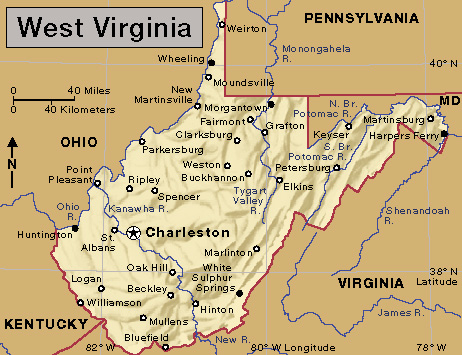
The beautiful mountain scenery of this rugged state attracts many visitors. Forests of valuable hardwood trees grow on the mountain slopes. Vast mineral deposits lie under the ground. West Virginia is one of the nation’s leading producers of coal. Coal deposits lie under about two-thirds of the land. West Virginia industries are based on coal and other mineral resources found in the state. These resources include crushed stone, natural gas, petroleum, salt, and sand. However, West Virginia’s economic base is shifting. Today, service industries are growing rapidly. They form the most important part of the economy.
The broad Ohio River forms West Virginia’s western border. Industrial cities line the riverbanks. Weirton and other northern river cities produce iron and steel. Chemical plants operate in the Ohio and Kanawha river valleys. West Virginia’s capital, Charleston, is in the Kanawha Valley. The Charleston area is a manufacturing center for chemicals and metal products. Aerospace equipment is made in Keyser. Huntington, Parkersburg, and many other cities have plants that manufacture glassware and pottery.

West Virginia was part of the state of Virginia until the American Civil War (1861-1865). Virginia joined the Confederate States in 1861. But the people of the northwestern counties remained loyal to the Union. They formed a new government, patterned after Virginia’s, and broke away from the rest of the state. West Virginia became a separate state in 1863. The hardy independence of West Virginians is reflected in the state’s motto, Mountaineers Are Always Free.
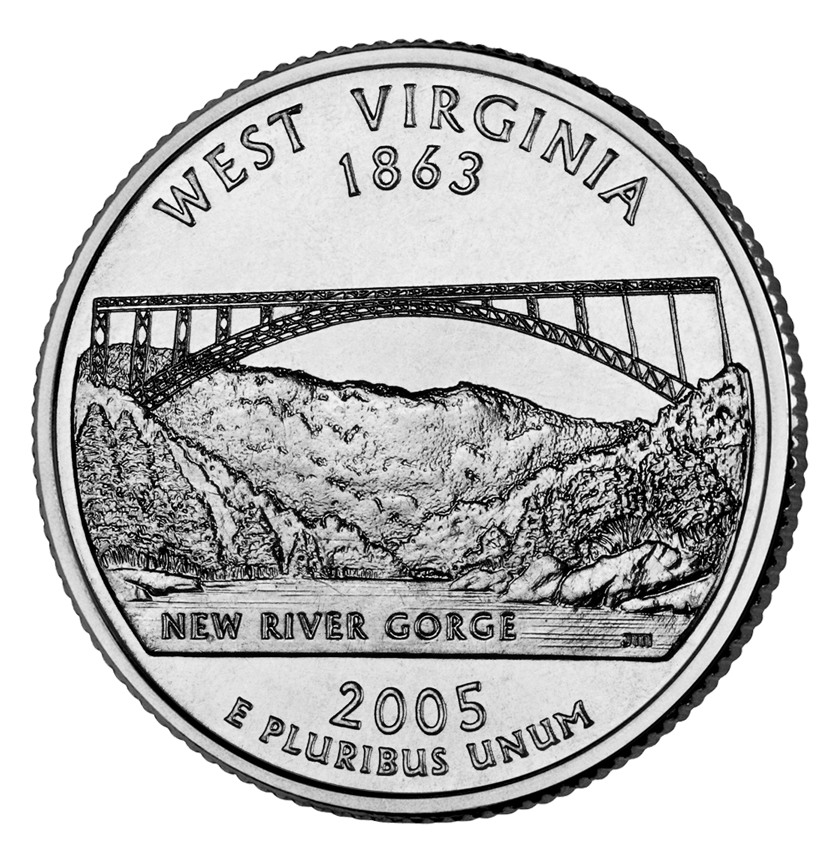
People
Population.
The 2020 United States census reported that West Virginia had 1,793,716 people. The population had decreased by 3 percent from the 2010 figure, 1,852,994. According to the 2020 census, West Virginia ranks 39th in population among the 50 states.
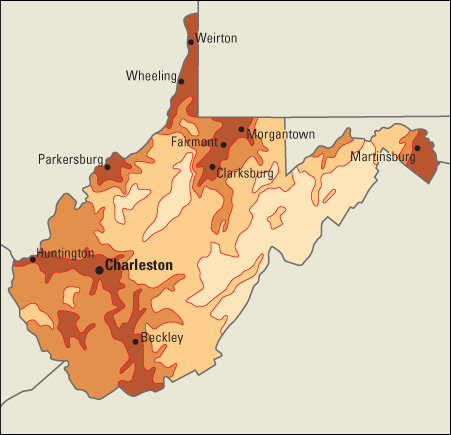
About 60 percent of West Virginia’s people live in metropolitan areas (see Metropolitan area). West Virginia has 10 metropolitan areas. Four of these lie entirely within West Virginia. Six metropolitan areas are partly in West Virginia and partly in one or more bordering states.
About half of the people of West Virginia live in rural areas. The state has about 180 cities, towns, and villages with populations of less than 2,500. Many were once coal-mining towns and trading centers for farm areas. West Virginia’s large cities lie in river valleys, where the land is least hilly. These large cities are centers for the chemical, iron, and steel industries. Charleston, Huntington, Morgantown, and Parkersburg are the largest cities.

Almost all the people of West Virginia were born in the United States. Many are of African, English, German, Irish, Italian, or Scotch-Irish descent. Many immigrants came to West Virginia during the late 1800’s and early 1900’s to work in the state’s coal mines.
Schools.
Pioneer children in the region that became West Virginia attended classes in log buildings. These buildings served both as schools and as churches. Parents paid schoolteachers in cash, in farm products, and with “bed and board.” In 1810, the Virginia legislature created a literary fund for the education of poor children.
The legislature passed a law in 1829 providing for free district schools in counties that wished to establish them. Few schools, however, were set up. Most state and county officials believed parents should pay to educate only their own children.
West Virginia established a free school system in 1863, after it became a state. The constitutions of 1863 and 1872 provided limited tax funds to support the schools. In 1876, the state adopted a graded school plan. The plan was developed by Alexander L. Wade of Monongalia County. In 1933, the state’s 398 school districts were replaced with 55 county systems.
Today, a state Board of Education administers the public schools. The board consists of 12 members, 9 of whom may vote. The governor appoints the voting members to nine-year terms. The board appoints a state superintendent of schools, who supervises the public school system. Children age 6 through 17 must attend school. For the number of students and teachers in West Virginia, see Education (table: U.S. students, teachers, and school expenditures).
Libraries.
A subscription library was operating in Wheeling as early as 1807. Members of this library contributed money to buy books, which they could use without charge. Public libraries were not common until after 1900. A state library commission was established in 1929 to help regulate and expand library services.
Today, many public library systems serve the people. Bookmobiles provide service for areas that lack libraries. The West Virginia University Library houses the West Virginia and Regional History Collection. The Rosanna Alexander Blake Library of Confederate History at Marshall University in Huntington is a collection of materials on the history of the Confederate States of America.
Museums.
The West Virginia State Museum is in the Cultural Center at the Capitol Complex in Charleston. The Clay Center for the Arts and Sciences of West Virginia, in Charleston, houses the Avampato Discovery Museum, the Juliet Art Museum, and a performance hall. Art museums include the Huntington Museum of Art, Parkersburg Art Center in Parkersburg, and the Oglebay Institute’s Mansion Museum in Wheeling. Museums at the Harpers Ferry National Historical Park feature displays on the American Civil War (1861-1865) and the 1859 armory raid by American abolitionist John Brown. 
Visitor’s guide
Beautiful scenery, mineral springs, and a variety of wildlife attract tourists, campers, hunters, and fishing enthusiasts to the mountains of West Virginia. The state’s Allegheny Mountains offer alpine and Nordic skiing. Kayakers, canoeists, and whitewater rafters enjoy such rivers as the New, the Gauley, the Cheat, and the Tygart Valley. West Virginia’s state parks and forests attract hikers and outdoor recreation enthusiasts. Tours of orchards, glass factories, and an exhibition coal mine offer glimpses into some of the industries that are important to the state.
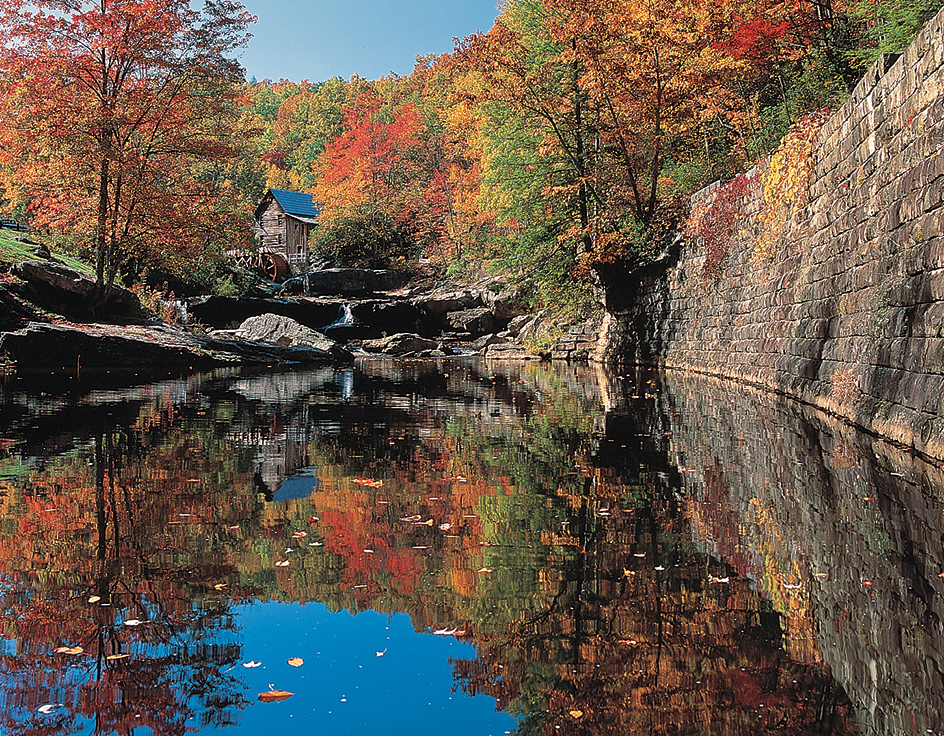
The Mountain State Forest Festival, in late September and early October at Elkins, ranks among the most colorful annual events in West Virginia. The majority of the festival takes place on the campus of Davis & Elkins College. Highlights of the festival include carnival rides, concerts, forestry exhibits, parades, and wood-chopping and sawing contests.
Land and climate
Land regions.
In most places, West Virginia’s boundaries follow the courses of rivers or the peaks of mountain chains. For this reason, the state has crooked boundaries. A narrow strip of West Virginia called the Northern Panhandle extends northward between Ohio and Pennsylvania. Another extension of West Virginia runs northward and eastward between Maryland and Virginia. It is called the Eastern Panhandle.

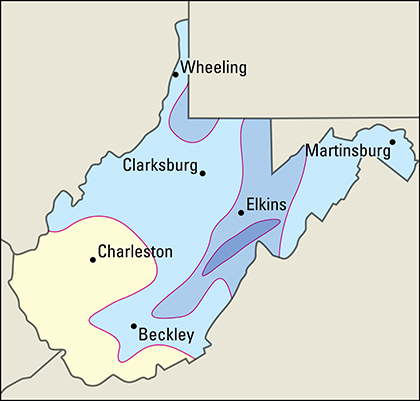
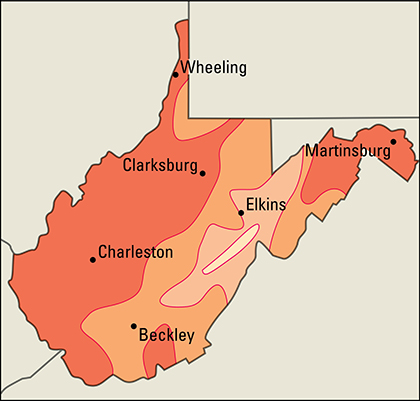
West Virginia has little level ground. Low mountains cover much of the eastern third of the state. Spruce Knob, the highest point in West Virginia, rises 4,861 feet (1,482 meters) above sea level near the eastern border. The widest valleys lie near the Ohio River in the west. There are also valleys in parts of the Eastern Panhandle between the Allegheny and Blue Ridge mountains.
West Virginia has two main land regions, the Appalachian Ridge and Valley Region, and the Appalachian Plateau.
The Appalachian Ridge and Valley Region
covers a wide strip along West Virginia’s eastern border. The Allegheny Mountains of this region belong to the Appalachian Mountain system. They form part of a series of long ridges and valleys that run from northeast to southwest across several eastern states. These mountains are made of folded layers of sedimentary rock. Sedimentary rock formed from deposits laid down by ancient rivers and seas. Erosion has worn down the softer layers. The erosion formed long parallel ridges of harder rock with valleys in between. Most streams and rivers run along the valleys between the ridges. A few streams cross the ridges in water gaps (breaks in the ridges). Some water gaps occur where weak rock was worn away. Other water gaps formed where streams cut through hard rock as nature lifted and folded it. Caves and underground streams are common throughout the region. Forests cover the mountainsides.
The Allegheny Front marks the western limits of the region. The Allegheny Front occurs where the sharply folded rock layers of the Appalachian Ridge and Valley Region meet the more gently folded layers of the Appalachian Plateau. The front appears in some places as a high, rugged escarpment (slope). In southern West Virginia, it becomes lost in the roughness of the southern Allegheny Mountains.
The Blue Ridge Mountains lie along the eastern borders of the Appalachian Ridge and Valley Region. These mountains are made of igneous rock and metamorphic rock. Igneous rock formed by the cooling of hot, melted material. Metamorphic rock is rock changed by heat and pressure.
The Appalachian Plateau
covers the entire state west of the Appalachian Ridge and Valley Region. The plateau has a rugged surface. Streams have carved narrow valleys. The streams left flat-topped uplands and rounded hills. The slopes are steep, especially in the west. Many peaks in the northeastern part of the region rise more than 4,000 feet (1,200 meters) above sea level.
Most of West Virginia’s coal, salt, petroleum, and natural gas deposits are found in the Appalachian Plateau. Nearly all the state’s larger cities lie in the river valleys of this region.
Rivers and lakes.
The Ohio River flows along the western boundary of West Virginia for over 275 miles (442 kilometers). It provides a route to the Mississippi River and the Gulf of Mexico. The major rivers of the Appalachian Plateau flow northwestward into the Ohio. The Kanawha River is the Ohio’s largest tributary in West Virginia. The Kanawha and New rivers and their branches drain a large portion of the state. The Big Sandy, Guyandotte, and Little Kanawha rivers also flow into the Ohio River.
The Monongahela River begins near the northern border of West Virginia. It flows northward through Pennsylvania. It helps form the Ohio River at Pittsburgh. The Monongahela and its branches form the main drainage system of north-central West Virginia. The Monongahela’s branches include the Cheat, Tygart Valley, and West Fork rivers. A separate system drains the Eastern Panhandle. The Shenandoah and other rivers in that region flow northward and eastward into the Potomac River.
West Virginia has no large natural lakes. Dams and reservoirs have been built to hold back water during flood seasons and to release it during periods of low flow. The reservoirs serve as lakes for fishing and recreation.
Plant and animal life.
Forests cover about four-fifths of West Virginia. The most important trees are beech, cherry, hickory, maple, oak, and poplar. Evergreen trees, including hemlock, red spruce, and white pine, grow on mountain ridges and plateaus. Evergreens also grow in river gorges.
The river valleys of West Virginia bloom with wildflowers from early spring to late fall. Bloodroot and hepaticas blossom beneath dogwood, redbud, white-blossomed hawthorn, and wild crab-apple trees. Azaleas and rhododendrons bloom in late spring and early summer. In autumn, the fields glow with asters, black-eyed Susans, and goldenrod.
White-tailed deer and black bears live in the mountains. Small woodland animals include gray and red foxes, minks, opossums, and raccoons. Many kinds of fish, including bass, trout, and walleyed pike, are found in the rivers and streams.
Climate.
West Virginia has warm summers and moderately cold winters. The valleys are usually warmer than the mountains. The average July temperature is 74 °F (23 °C). In the mountains, however, they are from 5 to 10 degrees Fahrenheit (3 to 6 degrees Celsius) cooler. January temperatures average about 31 °F (–1 °C) in the state. 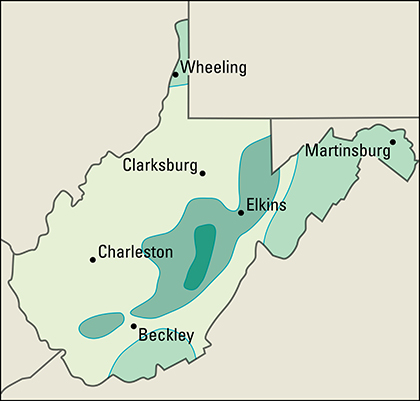
The state’s highest recorded temperature, 112 °F (44 °C), occurred at Moorefield on Aug. 4, 1930. the same temperature occurred at Martinsburg on July 10, 1936. West Virginia’s lowest recorded temperature, –37 °F (–38 °C), was set at Lewisburg on Dec. 30, 1917.
Rainfall is plentiful in all parts of the state. It is heaviest in the southern mountains. The upper Potomac River valley in the east gets the least rain. The ample rainfall benefits West Virginia’s agriculture and industry. But it also creates problems. Summer thunderstorms sometimes cause flash floods that damage property in valley settlements. Heavy winter and spring floods occur in the lower river valleys of West Virginia. Thick fogs often cover the valleys.
The southwest has the lightest snowfall—less than 20 inches (51 centimeters) a year. The mountains sometimes get as much as 100 inches (250 centimeters) of snowfall annually.
Economy
West Virginia’s economy is continuing its dramatic shift from a historical dependence on mining and manufacturing activities to an emphasis on service industries. Service industries, taken together, provide the greatest portion of West Virginia’s gross domestic product. Gross domestic product is the total value of goods and services produced in a year.
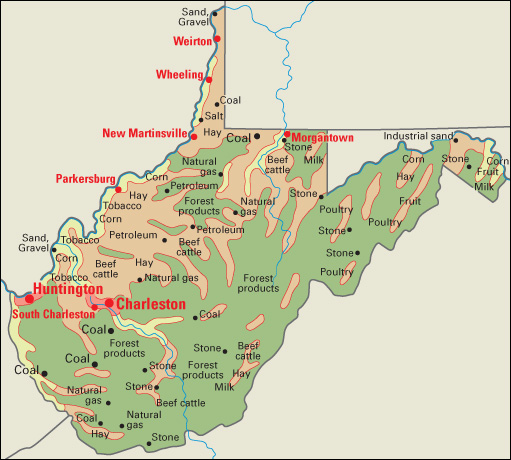
Chemical manufacturing and coal mining continue to play major roles in West Virginia’s economy. The Ohio and Kanawha river valleys are major centers of the chemical industry. West Virginia is also a leading coal producer. But the use of increasingly efficient machines and the establishment of strict environmental standards have reduced jobs in the coal industry. Jobs have also been lost due to the decline of West Virginia’s steel and glass industries. The state’s economy has begun to diversify into new kinds of manufacturing, as well as tourism.
Natural resources.
Few areas of similar size have so great a variety of resources as West Virginia. These resources include mineral deposits, timber, scenic recreational areas, and abundant rainfall.
Minerals
are West Virginia’s most valuable natural resources. Deposits of bituminous (soft) coal lie under about two-thirds of the state. Most of the coal deposits are in a broad belt that covers all of the southern and central counties. Fields of natural gas and petroleum-bearing sands are found in the western half of the state. Brine and rock salt come from the Ohio and Kanawha river valleys. Limestone is found in the mountains along the eastern border. Other products mined in West Virginia include portland cement and sand and gravel. 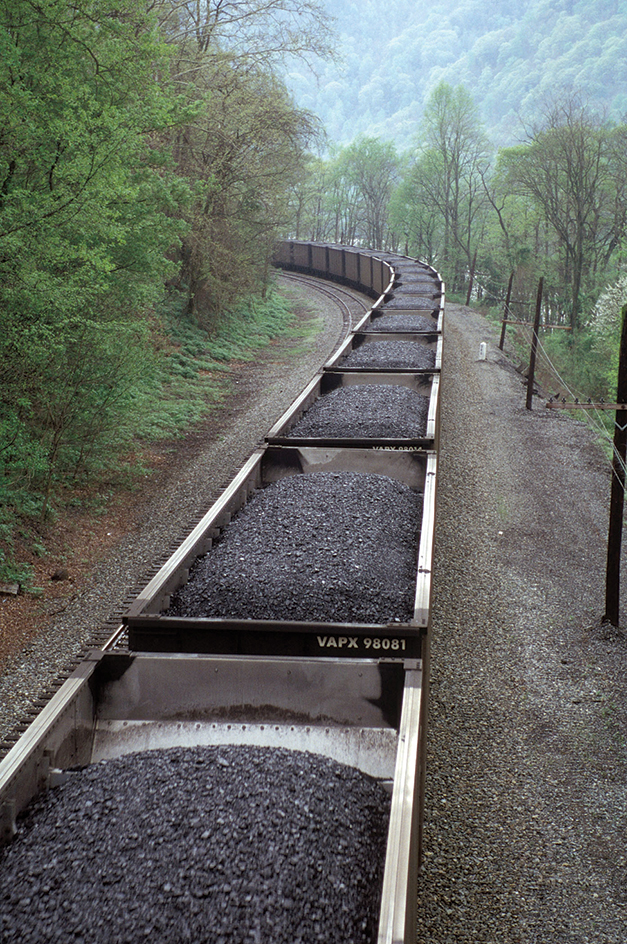
Soils.
The most fertile soils are in the river valleys. Some of the sandy soils that cover the rest of the state contain natural lime that makes the land especially good for grain crops and fruit trees.
Service industries
account for the largest parts both of the employment and of the gross domestic product of West Virginia. Most of the service industries are concentrated in the state’s metropolitan areas.
State government offices are based in Charleston, the state capital. Charleston is also the state’s chief financial center. The Federal Bureau of Investigation (FBI) has a large complex in Clarksburg. The category of service industries also includes the state’s fast-growing information technology sector. Many high-tech firms, especially computer-related companies, are concentrated in the Interstate 79 corridor from Morgantown to Weston. 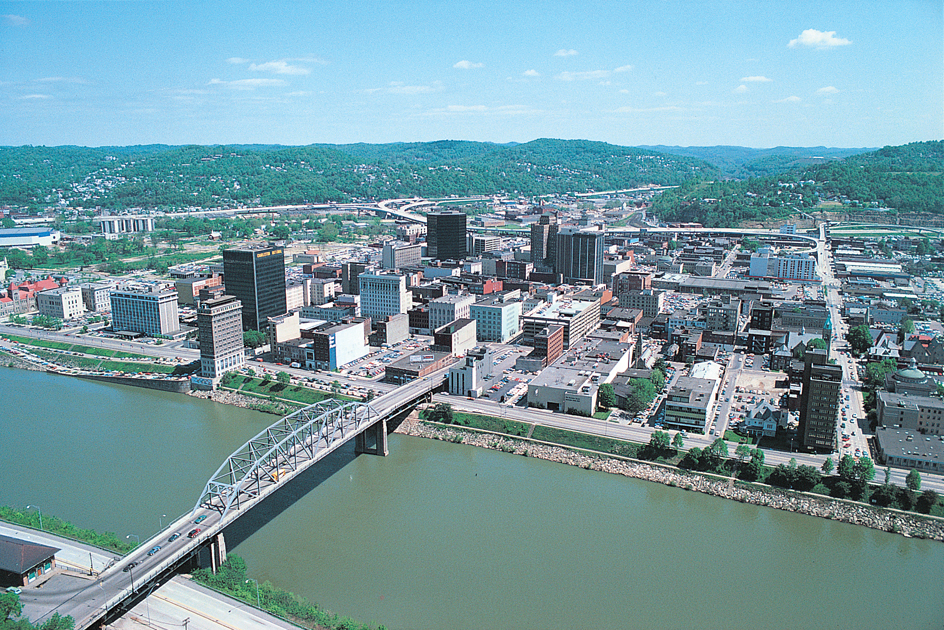
Manufacturing.
Chemicals are West Virginia’s leading manufactured product by far. The chemical industry operates chiefly in the Kanawha and Ohio river valleys. It uses coal, natural gas, oil, and salt found in the region. Factories in West Virginia make industrial chemicals, pharmaceuticals (medicinal drugs), and plastics.
Primary metals, transportation equipment, and wood products are also important manufactured products. Steel production centers in the Northern Panhandle, especially in Weirton. Major automobile parts manufacturers operate in the state. Keyser produces missiles and space vehicles. Many sawmills operate in the central and east-central part of the state. 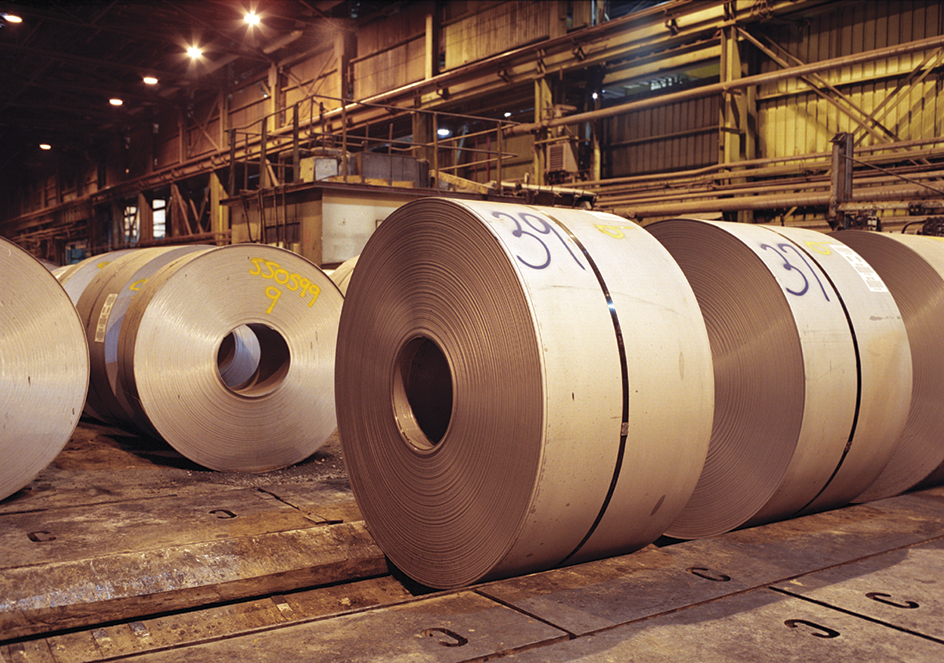

Other goods made in West Virginia include food products and stone, clay, and glass products. Baked goods and meat products are the state’s main food products. The state is known for its glassware and pottery. Glass products include blown glass, bottles, crystalware, plate glass, stained glass, structural glass, and table glassware. Pottery plants in Hancock County produce such products as chinaware, firebrick, paving brick, porcelain, and tile.
Mining.
Coal is West Virginia’s leading mined product. The state ranks among the leaders in coal production. Coal accounts for about 70 percent of West Virginia’s mining income. Bituminous coal is the only type of coal mined in the state. About two-thirds of the state has coal beneath it. The southern part of West Virginia has the largest coal reserves. Coal is mined in about half of the state’s counties. Boone, Kanawha, Logan, Marion, Marshall, Mingo, and Raleigh counties are among the leading producers.
Certain kinds of coal from the southern part of the state are low in sulfur. Since the Federal Clean Air Act of 1990 was enacted, these coals have been in high demand. Low-sulfur coals have good heating and steam-producing qualities. They are also rich in such by-products as coal tar and creosote.
Coal companies have made increasing use of advanced mining technology to improve efficiency. This has resulted in a need for fewer workers. Thus, some coal-mining regions of West Virginia have high unemployment rates.
Among West Virginia’s other mined products, natural gas is the most important. Natural gas fields lie under most of the western part of the state. Empty natural gas wells serve as storage places for gas from Louisiana, Oklahoma, or Texas. Pipelines carry the gas to West Virginia. It is stored in the empty wells during the summer for use locally and in the northeastern states during the winter, primarily for heating.
The state also mines crushed stone, petroleum, and sand and gravel. The northwestern part of the state produces the most petroleum. The petroleum is piped to a refinery at Newell. There it is processed into gasoline, fuel oil, and other products. Crushed stone comes mainly from limestone quarries in the eastern part of the state. Most of the state’s sand and gravel is obtained by dredging operations in the Ohio River.
Agriculture.
Farmland covers about a fourth of West Virginia’s area. Livestock and livestock products provide most of the farm income in West Virginia. Poultry and poultry products are among the state’s most valuable farm products. Broilers (young, tender chickens) are the leading poultry product. Eggs and turkeys are also important poultry products. Many poultry houses are in the northeastern part of the state. Beef cattle are also important. Many of the larger cattle ranches lie in the eastern part of the state. Dairy products are also important sources of farm income.
Crops account for much of West Virginia’s farm income. Hay and nursery and greenhouse products are the state’s leading plant products. Almost all the hay is fed to cattle. Other crops include corn, soybeans, and wheat. Much of West Virginia’s crops are grown in the Eastern Panhandle.
West Virginia’s farmers also raise vegetables, berries, and fruits. Apples and peaches are the leading fruit crops. The easternmost part of West Virginia is one of the best apple-growing regions in the eastern United States. Farmers in West Virginia were the first to grow the Grimes Golden and Golden Delicious apples.
Electric power and utilities.
Almost all of West Virginia’s electric power comes from steam plants that burn coal. Hydroelectric power and wind power produce most of the remaining power.
Transportation.
Much of the transportation in the state runs along the divides and valleys of the state’s major streams. Herds of buffaloes opened trails along the waterways while migrating westward. Later, Indigenous (native) American war and trading parties followed the same paths. Early settlers followed these trails and improved them for wagons. Many settlers traveled on trails along the Ohio River. Most communities developed along railroad lines built in the late 1800’s. Paved highways were developed in the 1920’s.
West Virginia has an extensive system of roads and highways. The West Virginia Turnpike runs between Charleston and Princeton. The state’s rugged terrain long hampered efforts to develop a road system. But the completion of the interstate highway system in West Virginia improved transportation within the state.
Rail lines provide freight service on thousands of miles of railroad track in the state. Charleston has West Virginia’s busiest airport.
West Virginia has hundreds of miles of navigable waterways. Ships and barges on West Virginia rivers carry chemicals, coal, lumber, oil, sand, steel, and other products. During the 1930’s, the federal government built a series of locks and dams on the Ohio River and its branches. These locks and dams improved the state’s rivers for barge traffic. The United States Army Corps of Engineers and the state’s Public Port Authority have continued to develop West Virginia’s waterways.
Communication.
The state’s first newspaper, the Potowmak Guardian and Berkeley Advertiser, appeared in Shepherdstown in 1790. The Intelligencer, founded in 1852 in Wheeling, is still being published. Other dailies published in West Virginia include The Charleston Gazette-Mail, The Dominion Post of Morgantown, The Herald-Dispatch of Huntington, The Parkersburg News and Sentinel, The Register-Herald of Beckley, and the Wheeling News-Register.
Government
Constitution.
West Virginia adopted its first constitution in 1863, when it became the 35th state in the Union. The state is now governed by its second constitution, adopted in 1872. The Constitution has been amended numerous times. Constitutional amendments may be proposed in either house of the state Legislature. They must be approved by a two-thirds majority of both houses, and then by a majority of the voters. The Constitution may also be revised by a constitutional convention. Before a convention can be called, it must be approved by a majority of the legislators and the voters.
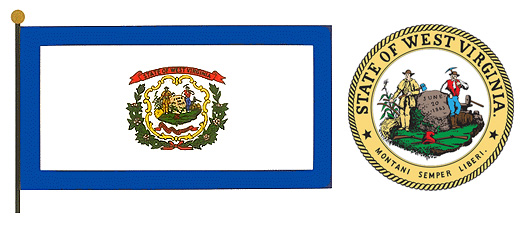
Executive.
The governor of West Virginia is elected to a four-year term. He or she may serve any number of terms, but not more than two terms in succession. The heads of many state administrative departments are appointed by the governor. Other top state officials include the secretary of state, auditor, treasurer, attorney general, and commissioner of agriculture. Each of these officials is elected to a four-year term.
Legislature
of West Virginia consists of the Senate and House of Delegates. The voters of each of the state’s 17 senatorial districts elect two senators to four-year terms. The House of Delegates has 100 members. The voters of each of the state’s 100 delegate districts elect one delegate to a two-year term. 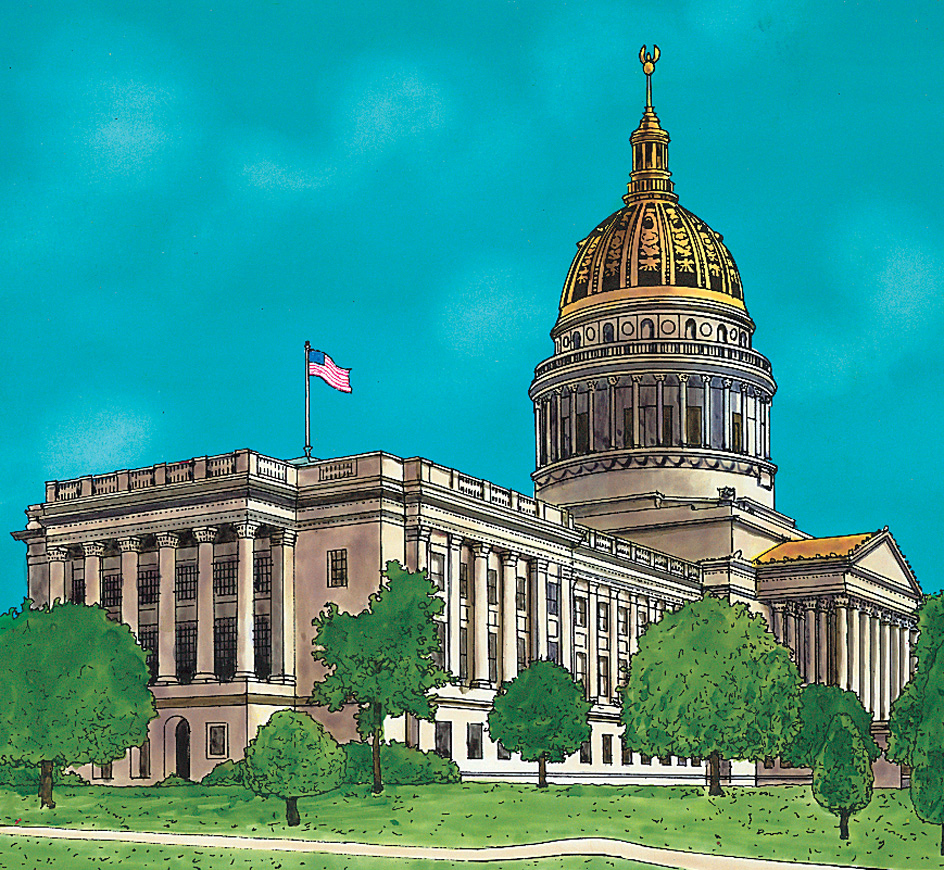
The Legislature meets every year. Regular sessions usually begin on the second Wednesday of January. However, in the year after an election for governor is held, the Legislature immediately adjourns until the second Wednesday of February. Regular sessions last 60 days. The governor may call special sessions or may be required to call them by a vote of the Legislature.
Courts.
The highest court in West Virginia is the Supreme Court of Appeals. It has five justices elected to 12-year terms. Every year, the court chooses a chief justice from among its members. The state is divided into 31 judicial circuits. Each circuit has a circuit court with one or more judges elected to eight-year terms. The circuit courts have jurisdiction in civil cases and cases involving felonies and misdemeanors.
Each West Virginia county has two or more magistrate courts. The magistrate courts hear civil cases that involve amounts of money of $10,000 or less. They also hear misdemeanor cases that are not handled by the circuit courts. Their judges, called magistrates, are elected to four-year terms. West Virginia’s family court system rules on divorce, child custody, and other family-related cases.
Local government.
Each of West Virginia’s 55 counties elects a circuit clerk and a county clerk. All counties elect three county commissioners except for Berkeley and Jefferson counties. Those counties elect five. That county elects five. All of these officials serve six-year terms. Other elected county officials include a prosecuting attorney, a sheriff, and an assessor. These officials serve four years.
A 1936 amendment to the state Constitution gives cities with populations of more than 2,000 the right to adopt or change their own charters. This right is called home rule. West Virginia’s home-rule cities are not as independent as home-rule cities of other states. This is because West Virginia courts continue to uphold the right of the state Legislature to control many city affairs. Most West Virginia cities have either a mayor-council or council-manager form of government.
Revenue.
Taxes account for about 40 percent of the state government’s general revenue (income). Most of the rest comes from federal grants and other U.S. government programs. West Virginia’s most important sources of tax revenue are a general sales tax and a personal income tax. Other sources of tax revenue include taxes on corporate income, insurance premiums, mining production, motor fuels, motor vehicle licenses, and tobacco products.
Politics.
In the late 1800’s, West Virginians usually voted Democratic. But from 1896 to 1928, the Republicans won every state election except one. The Democrats won control of the state in 1932 and held it until 1956. Since then, candidates from both main parties have won the governorship. Democrats usually had control of the Legislature, but Republicans made gains in the 2010’s. From the 1930’s to the 1990’s, West Virginia voters usually favored Democratic presidential candidates. The state preferred Republicans in presidential elections in the 2000’s.
History
Early days.
The first Indigenous Americans of the West Virginia area, known as Early Hunters, arrived about 14,000 years ago. They were nomadic hunters of large game. Woodland societies existed between about 1000 B.C. and A.D. 1700. The societies included mound builders. Mound builders constructed hundreds of burial mounds in the Ohio and Kanawha river valleys. One of the largest and most famous is Grave Creek Mound, at Moundsville (see Mound builders).
West Virginia’s Indigenous population was highest from about A.D. 1000 through the 1500’s. The population began declining in the 1600’s. Many Indigenous people were killed or driven out during tribal wars. The wars involved the Iroquois, Cherokee, and Shawnee. Epidemics of smallpox and other diseases also killed many Indigenous people. By the time white settlers arrived in the 1700’s, the Indigenous population had declined sharply.
White settlement.
The area that became West Virginia formed part of the Virginia Colony. King James I of England granted that colony to the Virginia Company of London, a business group, in 1606. White settlement began in what is now West Virginia in the 1700’s. A white settlement may have existed at Shepherdstown as early as 1717. Germans from Pennsylvania settled there in 1727. They called their settlement New Mecklenburg. One of the early settlers in the West Virginia region was Morgan Morgan. He arrived at Bunker Hill about 1731. Other settlements were soon founded. Many settlers were Germans and Scotch-Irish from what is now Northern Ireland. Most of the pioneers were farmers who settled in the Eastern Panhandle and the valleys of the Greenbrier River and the upper Monongahela River. In 1742, the explorers John Peter Salling (also spelled Salley) and John Howard discovered the great coal resources of West Virginia.
Indigenous raiders often attacked the settlers, who were taking over Indigenous hunting grounds. During the 1750’s and early 1760’s, they destroyed most of the West Virginia settlements. Hoping to satisfy the Indigenous groups, King George III of Britain issued the Proclamation of 1763. This law forbade settlements west of the Alleghenies until treaties could be made with the Indigenous leaders. Under treaties signed in 1768 and 1770, the Cherokee and Iroquois gave up their claims to lands between the Allegheny Mountains and the Ohio River. Settlers poured into the area. But the Shawnee people and their allies in the area believed their claims to land had been ignored. They attacked settlers. These clashes led to Lord Dunmore’s War in 1774. The war’s only major battle occurred at Point Pleasant. The Shawnee forces were defeated.
Before the American Revolution (1775-1783), land speculators tried to establish a new colony called Vandalia. The colony had Point Pleasant as its capital. It was to include most of what is now West Virginia west of the Alleghenies, plus southwestern Pennsylvania and eastern Kentucky. The American Revolution wrecked these plans. The Virginia Colony, which still included West Virginia, became the state of Virginia in 1788. Later, the Continental Congress rejected a proposed 14th state known as Westsylvania. The proposed state included much of Vandalia.
Between 1777 and 1782, during the revolution, West Virginia settlers faced frequent raids from Indigenous people. For protection, the settlers relied on defenses that included Fort Henry at Wheeling and Fort Randolph at Point Pleasant.
Early industries.
In 1794, Peter Tarr built the first iron furnace west of the Alleghenies near Weirton. About 1808, Samuel Jackson constructed an ironworks at Ice’s Ferry on the Cheat River. During the War of 1812 (1812-1815), Tarr supplied cannonballs for the U.S. Navy. Oliver Hazard Perry used Tarr’s cannonballs in his victory over the British on Lake Erie in 1813. Jackson’s ironworks supplied nails used in building Perry’s ships. Before the War of 1812, West Virginians had relied on imports of manufactured products from the United Kingdom. The war cut off trade with the United Kingdom. Manufacturing increased in West Virginia to make up for the loss. Wheeling became an important industrial center in the early 1800’s.
Abundant natural resources added to the growth of industry. Salt production in the Kanawha Valley made it one of the nation’s salt-making centers in the early 1800’s. Coal mines supplied fuel for salt production and iron manufacturing. In 1841, William Tompkins successfully used natural gas as a fuel at his salt furnaces.
Sectional strife.
During the early 1800’s, differences developed between eastern and western Virginia. Eastern Virginia was a region of large tobacco plantations worked by slave labor. In contrast, small self-sufficient family farms dotted most of western Virginia. The interests of the planters and the farmers often conflicted. The eastern planters controlled the state government and used it for their own advantage. Western Virginians protested many state policies. They objected to the state’s taxation, voting requirements, and legislative representation.
Western demands led to two important conventions to consider constitutional changes. In a convention held in 1829 and 1830, eastern delegates blocked major changes in the Constitution. Some western leaders called for the separation of the western counties from Virginia. The Reform Convention of 1850 and 1851 granted most western demands for political reforms. But it shifted more of the tax burden to the west. It also failed to deal with several economic concerns. In 1852, Joseph Johnson, a resident of Harrison County in the west, became the first popularly elected governor of Virginia. Even so, discontent in western Virginia continued.
The American Civil War and statehood.
The slavery question further divided eastern and western Virginians. In 1847, the Ruffner Pamphlet called for an end to slavery west of the Blue Ridge Mountains. A member of a prominent Kanawha Valley slaveholding family wrote the pamphlet. Disputes over slavery reached a climax in 1859. In that year, John Brown and his followers seized the federal arsenal at Harpers Ferry to protest slavery (see Brown, John). 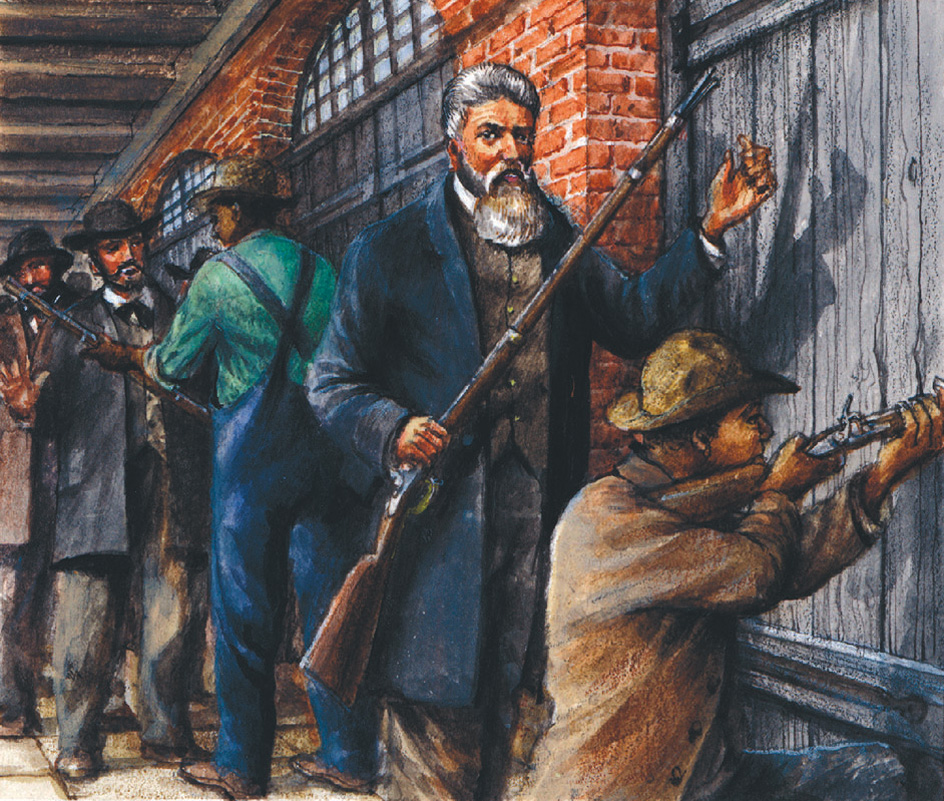
The American Civil War began on April 12, 1861. On April 17, the Virginia Secession Convention voted to leave the Union and join the Confederacy. Most of the delegates from present-day West Virginia opposed secession. Westerners held conventions in Wheeling in May and June. They declared that all state offices held by secessionists were vacant. The conventions set up the Reorganized Government of Virginia, with its capital in Wheeling. The Reorganized Government supported the Union during the Civil War.
In August 1861, western Virginians began the process of separating from Virginia. They planned to create a new state to be known as Kanawha. A constitutional convention met from November 1861 to February 1862. The convention wrote a constitution for the new state. It changed the name to West Virginia. After receiving approval from the U.S. Congress and President Abraham Lincoln, West Virginia was admitted to the Union as the 35th state on June 20, 1863. 
Although West Virginia was a Union state, it lay on a borderland between the North and South. Its location resulted in divided loyalties. Some of its people favored the Confederacy. The exact number of West Virginians who served in the Civil War is unknown. Unionists are believed to have outnumbered Confederates by a large margin. The most famous soldier from the state was Confederate General Stonewall Jackson.
An estimated 632 Civil War military actions took place in West Virginia. The Battle of Philippi on June 3, 1861, is sometimes called the first land battle of the war. Union armies captured the Monongahela and Kanawha valleys in the first year of the war. Many of the later military actions involved quick raids. With a victory in the Battle of Droop Mountain in 1864, Union forces gained control of most of West Virginia.
The Civil War ended in 1865. It had produced deep hatreds. Some of them lasted long after the conflict. Following the war, Radical Republican administrations took away political rights of approximately 15,000 West Virginians who had supported the Confederacy. Conditions resulting from the war played a part in the development of some family feuds. These disputes included the famous Hatfield-McCoy feud on the West Virginia-Kentucky border.
In 1870, Democrats won the governorship and most seats in the state Legislature. They restored the political rights the Radical Republicans had taken away. They also wrote the state’s present constitution. The voters approved the Constitution in 1872. Wheeling served as the first state capital. The city lay in the heart of Republican territory. . Following the Democratic victories of 1870, the capital was transferred to Charleston. Wheeling became the capital again in 1875. But two years later, the people voted to make Charleston the permanent capital. The move back to Charleston took place in 1885.
Industrial growth.
When West Virginia entered the Union, about 90 percent of its people were farmers. In the last decades of the 1800’s, however, the state experienced an industrial revolution. The revolution was based on coal, timber, oil, natural gas, and other resources. New industries developed in part because of the building of railroads. By 1900, coal had become the state’s leading industry. West Virginia was one of the nation’s top oil-producing states in the late 1800’s and early 1900’s. Israel C. White of West Virginia became a world-famous oil geologist. From 1906 to 1924, the state led the nation in natural gas production. West Virginia’s forests provided wood for large-scale timber and lumber development.
Manufacturing expanded in the 1900’s. The production of chemicals, glass, and iron, steel, and other metals gained importance. Wheeling and Weirton became iron and steel centers. Chemical industries developed in the Kanawha and Ohio valleys. The Kanawha Valley emerged as one of the chemical centers of the world. The presence of rich silica sands, natural gas, and limestone contributed to the development of the glass industry. A glass plant operated in nearly every major town. The invention of a bottle-making machine and other devices by Michael J. Owens of West Virginia further aided glass production in the state. The participation of the United States in World War I in 1917 and 1918 generated manufacturing needed to produce war supplies.
Labor developments.
The needs of industry led to a large wave of immigration into West Virginia in the late 1800’s and early 1900’s. Coal companies recruited workers from European countries. Many workers came from Italy, Hungary, and Poland. Glassmaking in the Kanawha Valley attracted skilled workers from Belgium. African Americans left southern states for jobs in the state’s mines.
Labor disputes about wages, hours, and working conditions became common. Some disputes led to violence. In 1877, a railroad strike that began at Martinsburg became the first U.S. nationwide industrial strike. Labor made some of its earliest gains through the organization of craft unions. The West Virginia Federation of Labor was organized in 1903. It included 270 craft unions by 1914.
In the 1880’s, most of West Virginia’s nonunion workers were coal miners. In 1897, the United Mine Workers of America (UMWA) held a large rally at Wheeling. There, it attempted to organize West Virginia miners. But it had little success. Coal mine operators fought back. Their methods included court injunctions, mine guards, and special police. In 1902, with the help of Mary Harris Jones—called “Mother Jones”—the UMWA organized miners in the Kanawha Valley.
In 1912 and 1913, Kanawha mine operators refused to renew contracts. Miners on Paint Creek and Cabin Creek went on strike. During the conflict, 12 miners and 4 company guards were killed at Mucklow (now Gallagher, near Montgomery). Governor William E. Glasscock imposed martial law twice to try to halt the conflict. After Governor Henry D. Hatfield took office in 1913, the union and the operators agreed to a new contract. The contract provided a nine-hour workday and the right to organize workers.
Labor unrest occurred in Logan and Mingo counties between 1919 and 1921. Mine operators attempted to prevent unionization. About 5,000 miners from the Kanawha Valley prepared to march on Logan. Governor John J. Cornwell persuaded most of them to return home. Other miners gave in when Cornwell threatened to call in federal troops.
In 1920, clashes at Matewan between miners and agents employed by operators led to several deaths. Seven company detectives, two union members, and the town’s mayor died. The incident is called the Matewan Massacre. In August 1921, approximately 5,000 miners, angry over continued violence, gathered at Marmet. They staged a protest march on Logan. Between 1,200 and 1,300 state police, deputy sheriffs, armed guards, and others stopped the marchers. They halted at Blair Mountain, near the Boone-Logan county line. A battle raged for four days. At the request of Governor Ephraim Morgan, 2,100 federal troops were sent to Blair Mountain. The federal forces included a chemical warfare unit and bomber and fighter planes. The miners surrendered. Later, 543 people were indicted on charges that included murder, treason, and carrying guns.
Union membership dropped sharply after 1921. However, the federal government’s National Industrial Recovery Act (NIRA) of 1933 established the right of labor unions to bargain collectively. NIRA, later replaced by the Wagner Act, also established minimum wages, shortened workdays, and improved working conditions.
An era of change.
The Great Depression of the 1930’s brought economic hardship to West Virginia and the rest of the country. The United States entered World War II in 1941. From then until the war ended in 1945, manufacturing boomed. The state helped provide supplies for the war effort. During the 1950’s, West Virginia entered a period of economic change. Many industries that used coal for power switched to other energy sources. Coal production declined. New mining machines reduced the need for workers. As jobs disappeared, large numbers of people left the state. Between 1950 and 1970, West Virginia’s population declined by about 13 percent.
Green Bank, West Virginia, became the home of a major radio astronomy facility in 1959. The observatory’s several telescopes include the Robert C. Byrd Green Bank Telescope, which began operating in 2001.

West Virginia’s economic problems attracted national attention to its Democratic presidential primary election of 1960. John F. Kennedy defeated Hubert H. Humphrey, the leading Democratic candidate. Kennedy’s stunning victory was the turning point in his successful bid for the nomination. He became president in 1961. From 1961 to 1969, the administrations of Kennedy and his successor, Lyndon B. Johnson, promoted economic programs that brought some improvements to West Virginia’s economy. Also, during the 1970’s, international oil shortages and high prices aided the coal industry. The state’s population increased by about 12 percent during the decade.
Recent developments.
The economic upturn of the 1960’s and 1970’s reversed during the 1980’s. West Virginia faced high unemployment. The population declined by about 71/2 percent between 1980 and 1990.
The 1990’s brought some signs of economic development, however. The state’s timber industry expanded. Tourism grew. After several years of decline, coal production increased. Beginning in the late 1990’s, several Japanese companies brought manufacturing operations to the state. In the early 2000’s, sharp increases in oil prices made coal competitive. By the 2010’s, however, cheaper prices for such energy sources as wind, solar, and natural gas reduced the demand for coal. A number of coal mines closed, and thousands of miners lost their jobs. From 1990 to 2010, the state’s population increased by about 3 percent.
Robert C. Byrd of West Virginia served as chairman of the United States Senate Appropriations Committee from 1988 to 1995. In that post, he helped the state win federal projects that created hundreds of jobs. The projects included a Federal Bureau of Investigation (FBI) fingerprint center at Clarksburg. The state also won federal highway construction and water development projects. A stretch of Interstate 79 in north-central West Virginia emerged as a high-tech corridor. It became one of the state’s new economic centers.
In 2006, the West Virginia state Legislature passed several new mine safety laws after 14 miners died in two separate incidents. The laws called for systems to better track lost miners, stockpile oxygen for trapped miners, and improve response times in emergencies. In April 2010, a huge mine explosion killed 29 miners in Montcoal, in the southwestern part of the state.
In June 2016, heavy rains contributed to widespread and destructive flooding throughout the state. Floods killed about 25 West Virginians and left thousands homeless. Greenbrier County, in southeastern West Virginia, experienced some of the worst damage and loss of life.
Jim Justice, a billionaire who ran his family’s coal and agriculture businesses, won the state’s 2016 campaign for governor. Justice, who was elected as a Democrat, changed his party affiliation to Republican in 2017. In 2018, the House of Delegates voted to impeach four of the justices on the state’s Supreme Court of Appeals. A fifth justice resigned prior to the vote. Each of the justices had been accused of the improper use of state funds. In subsequent trials held in the Senate, senators voted to remove three of the four justices from office.
Congress redesignated the New River Gorge National River as New River Gorge National Park and Preserve in 2021. The national park designation recognized the gorge’s natural beauty and opportunities for recreation.
